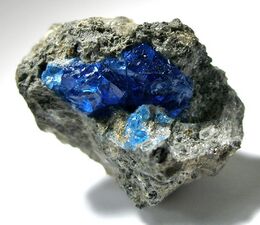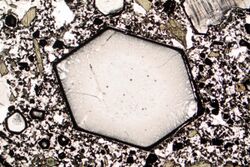Chemistry:Hauyne
| Haüyne | |
|---|---|
 Hauyne from Mayen, Eifel Mts, Rhineland-Palatinate, Germany | |
| General | |
| Category | Tectosilicate, sodalite group |
| Formula (repeating unit) | Na 3Ca(Si 3Al 3)O 12(SO 4)[1] |
| Strunz classification | 9.FB.10 (10 ed) 8/J.11-30 (8 ed) |
| Dana classification | 76.2.3.3 |
| Crystal system | Isometric |
| Crystal class | Hextetrahedral (43m) H-M symbol (4 3m) |
| Space group | P43n |
| Unit cell | a = 9.08 – 9.13 Å; Z = 2 |
| Identification | |
| Formula mass | 1,032.43 g/mol[2] |
| Color | Blue, white, gray, yellow, green, pink |
| Crystal habit | Dodecahedral or pseudo-octahedral |
| Twinning | Common on {111} |
| Cleavage | Distinct on {110} |
| Fracture | Uneven to conchoidal |
| Tenacity | Brittle |
| Mohs scale hardness | 5 to 6 |
| |re|er}} | Vitreous to greasy |
| Streak | Very pale blue to white |
| Diaphaneity | Transparent to translucent |
| Specific gravity | 2.4 to 2.5 |
| Optical properties | Isotropic |
| Refractive index | n = 1.494 to 1.509 |
| Birefringence | None, isotropic |
| Pleochroism | None, isotropic |
| Fusibility | 4.5[3] |
| Solubility | Gelatinises in acids |
| Other characteristics | May fluoresce orange to pink under longwave ultraviolet light[4][5] |
| References | [2][3][4][5] |
Hauyne or haüyne, also called hauynite or haüynite (/ɑːˈwiːnaɪt/ ah-WEE-nyte),[7] is a tectosilicate sulfate mineral with endmember formula Na
3Ca(Si
3Al
3)O
12(SO
4).[1] As much as 5 wt % K
2O may be present, and also H
2O and Cl. It is a feldspathoid and a member of the sodalite group.[3][4] Hauyne was first described in 1807 from samples discovered in Vesuvian lavas in Monte Somma, Italy,[8] and was named in 1807 by Brunn-Neergard for the French crystallographer René Just Haüy (1743–1822).[3] It is sometimes used as a gemstone.[9]
Sodalite group
Formulae:[1]
- haüyne Na
3Ca(Si
3Al
3)O
12(SO
4) - sodalite Na
4(Al
3Si
3)O
12Cl - nosean Na
8(Al
6Si
6)O
24(SO
4) · H2O - lazurite Na
3Ca(Si
3Al
3)O
12S - tsaregorodtsevite N(CH
3)
4Si
4(SiAl)O
12 - tugtupite Na
4BeAlSi
4O
12Cl - vladimirivanovite Na Na
6Ca
2[Al
6Si
6O
24](SO
4,S
3,S
2,Cl)
2 · H2O
All these minerals are feldspathoids. Haüyne forms a solid solution with nosean and with sodalite. Complete solid solution exists between synthetic nosean and haüyne at 600 °C, but only limited solid solution occurs in the sodalite-nosean and sodalite-haüyne systems.[10]
The characteristic blue color of sodalite-group minerals arises mainly from caged S−
3 and S
4 clusters.[11]
Unit cell
Haüyne belongs to the hexatetrahedral class of the isometric system, 43m, space group P43n. It has one formula unit per unit cell (Z = 1), which is a cube with side length of 9 Å. More accurate measurements are as follows:
- a = 8.9 Å[2]
- a = 9.08 to 9.13 Å[5]
- a = 9.10 to 9.13 Å[10]
- a = 9.11(2) Å[4]
- a = 9.116 Å[3]
- a = 9.13 Å[12]
Structure
All silicates have a basic structural unit that is a tetrahedron with an oxygen ion O at each apex, and a silicon ion Si in the middle, forming (SiO4)4−. In tectosilicates (framework silicates) each oxygen ion is shared between two tetrahedra, linking all the tetrahedra together to form a framework. Since each O is shared between two tetrahedra only half of it "belongs" to the Si ion in either tetrahedron, and if no other components are present then the formula is SiO2, as in quartz.
Aluminium ions Al, can substitute for some of the silicon ions, forming (AlO4)5− tetrahedra. If the substitution is random the ions are said to be disordered, but in haüyne the Al and Si in the tetrahedral framework are fully ordered.[3]
Si has a charge 4+, but the charge on Al is only 3+. If all the cations (positive ions) are Si then the positive charges on the Si's exactly balance the negative charges on the O's. When Al replaces Si there is a deficiency of positive charge, and this is made up by extra positively charged ions (cations) entering the structure, somewhere in between the tetrahedra.
In haüyne these extra cations are sodium Na+ and calcium Ca2+, and in addition the negatively charged sulfate group (SO4)2− is also present. In the haüyne structure the tetrahedra are linked to form six-membered rings that are stacked up in an ..ABCABC.. sequence along one direction, and rings of four tetrahedra are stacked up parallel to another direction. The resulting arrangement forms continuous channels that can accommodate a large variety of cations and anions.[10]
Appearance
Haüyne crystallizes in the isometric system forming rare dodecahedral or pseudo-octahedral crystals that may reach 3 cm across; it also occurs as rounded grains. The crystals are transparent to translucent, with a vitreous to greasy luster. The color is usually bright blue, but it can also be white, grey, yellow, green and pink.[3][4][5] In thin section the crystals are colorless or pale blue,[5][12] and the streak is very pale blue to white.
Optical properties
Haüyne is isotropic. Truly isotropic minerals have no birefringence, but haüyne is weakly birefringent when it contains inclusions.[5][12] The refractive index is 1.50; although this is quite low, similar to that of ordinary window glass, it is the largest value for minerals of the sodalite group.[12] It may show reddish orange to purplish pink fluorescence under longwave ultraviolet light.[4][5]
Physical properties
Cleavage is distinct to perfect, and twinning is common, as contact, penetration and polysynthetic twins.[3] The fracture is uneven to conchoidal, the mineral is brittle, and it has hardness 5 1⁄2 to 6, almost as hard as feldspar. All the members of the sodalite group have quite low densities, less than that of quartz; haüyne is the densest of them all, but still its specific gravity is only 2.44 to 2.50.[12] If haüyne is placed on a glass slide and treated with nitric acid HNO3, and then the solution is allowed to evaporate slowly, monoclinic needles of gypsum form. This distinguishes haüyne from sodalite, which forms cubic crystals of chlorite under the same conditions.[12] The mineral is not radioactive.[2]
Geological setting and associations
Haüyne occurs in phonolites and related leucite- or nepheline-rich, silica-poor, igneous rocks; less commonly in nepheline-free extrusives[2][3][4][5] and metamorphic rocks (marble).[3] Associated minerals include nepheline, leucite, titanian andradite, melilite, augite, sanidine, biotite, phlogopite and apatite.[5]
Localities

The type locality is Lake Nemi, Alban Hills, Rome Province, Latium, Italy.[4]
Occurrences include:
- Canary Islands: A pale blue mineral intermediate between haüyne and lazurite has been found in spinel dunite xenoliths from La Palma, Canary Islands.[13]
- Ecuador: Phenocrysts found in alkaline extrusive rocks (tephrite), product of effusive volcanism of the Sumaco volcano, of northeast Ecuador.
- Germany: In ejected rocks of hornblende-haüyne-scapolite rock from the Laach lake volcanic complex, Eifel, Rhineland-Palatinate[12]
- Italy: Anhedral blue to dark grey phenocrysts in leucite-melilite-bearing lava at Monte Vulture, Melfi, Basilicata, Potenza[10]
- Italy: Millimetric transparent blue crystals in ejecta consisting mainly of K-feldspar and plagioclase from Albano Laziale, Roma[10]
- Italy: Ejected blocks in the peperino of the Alban Hills, Rome Province, Latium, contain white octahedral haüyne associated with leucite, garnet, melilite and latiumite.[12]
- US: Haüyne of metamorphic origin occurs at the Edwards Mine, St. Lawrence County, New York.[3]
- US: Haüyne occurs in nepheline alnoite with melilite, phlogopite and apatite at Winnett, Petroleum County, Montana, US.[3]
- US: Haüyne is common in small quantities as phenocrysts in phonolite and lamprophyre at the Cripple Creek, Colorado Mining District, Colorado, US.[14]
See also
- Chemistry:Lapis lazuli – Metamorphic rock containing lazurite, prized for its intense blue color
- Chemistry:Lazurite – Alumino-silicate mineral whose blue colour is due to a sulfide species and not copper
References
- ↑ 1.0 1.1 1.2 "IMA Mineral List with Database of Mineral Properties". http://rruff.info/ima.
- ↑ 2.0 2.1 2.2 2.3 2.4 "Hauyne". Webmineral.com. http://webmineral.com/data/Hauyne.shtml.
- ↑ 3.00 3.01 3.02 3.03 3.04 3.05 3.06 3.07 3.08 3.09 3.10 3.11 Gaines et al (1997) Dana’s New Mineralogy Eighth Edition. Wiley
- ↑ 4.0 4.1 4.2 4.3 4.4 4.5 4.6 4.7 "Hauyne". Mindat.org. http://www.mindat.org/min-1833.html.
- ↑ 5.0 5.1 5.2 5.3 5.4 5.5 5.6 5.7 5.8 "Handbook of Mineralogy". http://www.handbookofmineralogy.com/pdfs/hauyne.pdf.
- ↑ Warr, L.N. (2021). "IMA–CNMNC approved mineral symbols". Mineralogical Magazine 85 (3): 291–320. doi:10.1180/mgm.2021.43. Bibcode: 2021MinM...85..291W.
- ↑ "haüynite". Dictionary.com Unabridged. Random House. https://www.dictionary.com/browse/ha%C3%BCynite.
- ↑ Farndon and Parker (2009). Minerals, Rocks and Fossils of the World. Lorenz Books
- ↑ Tables of Gemstone Identification By Roger Dedeyne, Ivo Quintens, p.109
- ↑ 10.0 10.1 10.2 10.3 10.4 Bellatreccia, Della Ventura, Piccinini, Cavallo and Brilli (2009): H2O and CO2 in minerals of the haüyne-sodalite group: an FTIR spectroscopy study. Mineralogical Magazine 73:399-413
- ↑ Chukanov, Nikita V.; Sapozhnikov, Anatoly N.; Shendrik, Roman Yu.; Vigasina, Marina F.; Steudel, Ralf (23 November 2020). "Spectroscopic and Crystal-Chemical Features of Sodalite-Group Minerals from Gem Lazurite Deposits". Minerals 10 (11): 1042. doi:10.3390/min10111042. Bibcode: 2020Mine...10.1042C.
- ↑ 12.0 12.1 12.2 12.3 12.4 12.5 12.6 12.7 Deer Howie and Zussman (1963) Rock-forming minerals, Volume 4, Framework Silicates, pages 289 to 302
- ↑ Wulff-Pedersen et al (2000) American Mineralogist 85:1397-1405
- ↑ Carnein and Bartos (2005) Mineralogical Record 36-2:173
External links
- JMol: http://rruff.geo.arizona.edu/AMS/viewJmol.php?id=05334
- Nasti, Vincenzo (2009). "L’Olotipo della Haüyna. Il Cercapietre, Notiziario del Gruppo Mineralogico Romano, N° 1–2/". pp. 16–43. https://gminromano.it/wp-content/uploads/2021/03/CP2009-art2.pdf.
- Nasti, Vincenzo (2019–2020). "La riscoperta del minerale di Nemi Lazialite – Haüyna". p. 40. https://gminromano.it/wp-content/uploads/2021/03/Cp2019-2020-Art06.pdf.
 |

